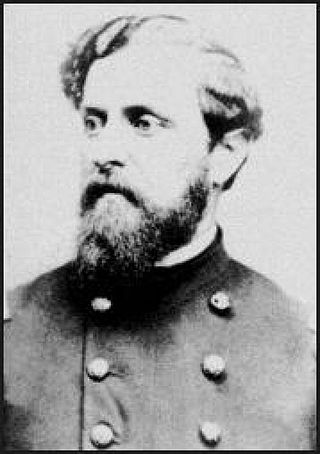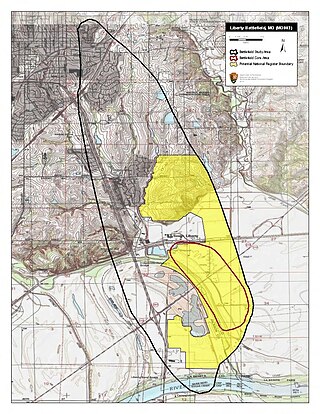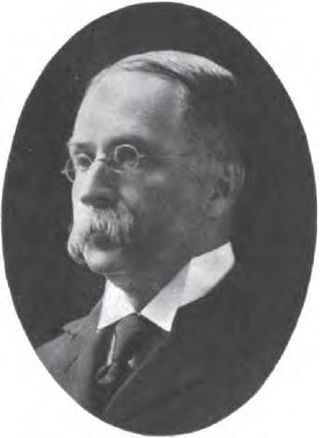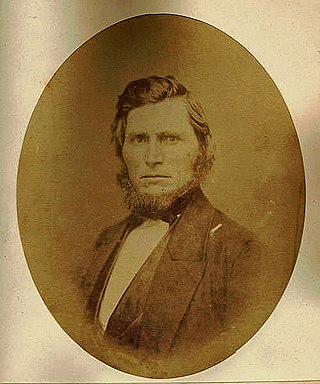Sources
- The History of Washington County, Iowa Union County Historical Society. 1880. pp. 523–527.
- Iowa: The Middle Land Dorothy Schwieder. 1996. University of Iowa Press. pp. 77–78.
Talley's War also called the Skunk River War was an incident in 1863 in Iowa, in which pro-war individuals opened fire on a peace demonstration; one person was killed.
Cyphert (or Syphert) Talley was a pro-peace Baptist minister whose family moved into the Keokuk county, Iowa area from Tennessee in 1840. During the Civil War, Talley became known in Keokuk County for pro-peace speeches, which sometimes drew an armed audience. On Saturday, August 1, 1863, Talley spoke at a Democratic rally near the English river to an audience of hundreds. After the rally, Talley and others of his crowd rode in wagons to the nearby town of South English, Iowa, where a meeting of Republicans had taken place. Talley was warned not to enter the town, but did anyway, to accusations of his cowardice. According to an 1880 recounting of the event, the Democrats in wagons displayed their weapons at these cries to the equally well-armed people in the town. It was said that a town's person started the firing. Hundreds of shots were fired, but only Talley died.
Talley's friends sent out the word of his death widely, and the next day people began to arrive in answer to the news, demanding vengeance. A citizen committee reassured the first hundred who assembled that the guilty party would be sought and brought to justice, but the crowd continued to gather, until hundreds of men had formed by the Skunk River into what would later be known as the Skunk River Army. Several citizens of the town made an excursion to Davenport, Iowa, to appeal to Governor Kirkwood, who travelled with several hundred troops and cannons to the area. While the action brought legends of the terrified retreat of the Skunk River Army, the fact is that the army had all but disbanded before the governor arrived.
All told, eleven companies were engaged in quelling uprisings in August 1863 in Keokuk County.
No one was indicted for the crime of shooting Talley, although the placement of the wound suggested it was intentionally inflicted. Citizens of the area kept the identity of the shooter to themselves.

Keokuk is a city in and a county seat of Lee County, Iowa, United States. It is Iowa's southernmost city. The population was 9,900 at the time of the 2020 census. The city is named after the Sauk chief Keokuk, who is thought to be buried in Rand Park. It is in the extreme southeast corner of Iowa, where the Des Moines River meets the Mississippi. It is at the junction of U.S. Routes 61, 136 and 218. Just across the rivers are the towns of Hamilton and Warsaw, Illinois, and Alexandria, Missouri. Keokuk, along with the city of Fort Madison, is a principal city of the Fort Madison-Keokuk micropolitan area, which includes all of Lee County, Iowa, Hancock County, Illinois and Clark County, Missouri.

Oskaloosa is a city in, and the county seat of, Mahaska County, Iowa, United States. In the late nineteenth and early twentieth century, Oskaloosa was a national center of bituminous coal mining. The population was 11,558 in the 2020 U.S. Census, an increase from 10,938 in 2000.

Keokuk was a leader of the Sauk tribe in central North America, and for decades was one of the most recognized Native American leaders and noted for his accommodation with the U.S. government. Keokuk moved his tribe several times and always acted as an ardent friend of the Americans. His policies were contrary to fellow Sauk leader Black Hawk, who led part of their band to defeat in the Black Hawk War, was later returned by U.S. forces to Keokuk's custody, and who died a decade before Keokuk.

George Pomutz was a Romanian-American officer during the Hungarian Revolution of 1848 against the Habsburgs, a general in the Union Army in the American Civil War, a lawyer, and a diplomat.

The action at Blue Mills Landing, also known as the Battle of Liberty, was a battle of the American Civil War that took place on September 17, 1861, in Clay County, Missouri. Union forces unsuccessfully attempted to prevent pro-Southern Missouri State Guards from northwestern Missouri from crossing the Missouri River near the confluence with the Blue River to reinforce Sterling Price at Lexington.

The Battle of Corydon was a minor engagement that took place July 9, 1863, just south of Corydon, which had been the original capital of Indiana until 1825, and was the county seat of Harrison County. The attack occurred during Morgan's Raid in the American Civil War as a force of 2,500 cavalry invaded the North in support of the Tullahoma Campaign. It was the only pitched battle of the Civil War that occurred in Indiana, and no battle has occurred within Indiana since.

The Battle of Ringgold Gap was fought November 27, 1863, outside the town of Ringgold, Georgia, by the Confederate and Union armies during the American Civil War. Part of the Chattanooga Campaign, it followed a heavy Confederate loss at the Battle of Missionary Ridge from which General Braxton Bragg's artillery and wagon trains were forced to retreat south. The five hour Battle of Ringgold Gap resulted in the Confederate victory of Major General Patrick R. Cleburne and gave the Army of Tennessee safe passage to retreat through the Ringgold Gap mountain pass.
John Joshua Webb was a noted lawman turned gunfighter and outlaw of the American Old West.
Popular opposition to the American Civil War, which lasted from 1861 to 1865, was widespread. Although there had been many attempts at compromise prior to the outbreak of war, there were those who felt it could still be ended peacefully or did not believe it should have occurred in the first place. Opposition took the form of both those in the North who believed the South had the right to be independent and those in the South who wanted neither war nor a Union advance into the newly declared Confederate States of America.
The Battle of Athens was an American Civil War skirmish that took place in northeast Missouri in 1861 near present Revere and southeast Iowa along the Des Moines River across from Croton. The Union victory has the distinction of being the most northerly of Civil War Battles fought west of the Mississippi, and also of being the only such battle fought along the Iowa border.

The state of Iowa played a significant role during the American Civil War in providing food, supplies, troops and officers for the Union army.

Francis Marion Drake was an American merchant, lawyer, banker and politician. He fought in the American Civil War and later became the 16th Governor of Iowa. He is the namesake of Drake University.
The 36th Iowa Infantry Regiment was an infantry regiment that served in the Union Army during the American Civil War.

John Nichol Irwin was an American businessman, politician and diplomat. Among the positions he held were Mayor of Keokuk, Iowa, Governor of Idaho Territory, Governor of Arizona Territory, and U.S. Minister to Portugal.
Davenport, Iowa, was part of the Louisiana Purchase. In 1814, during the War of 1812 the British military, along with the Saux and Fox Indian tribes fought against the Americans near Davenport. In August, Major Zachary Taylor, later President, fought a battle east of what is now Credit Island Park, in Davenport. An outpost was set up at Fort Armstrong and George Davenport and Antonie LeClaire were stationed there.

Antoine Le Claire was a US Army interpreter, landowner in Scott County, Iowa, and Rock Island County, Illinois, businessman, philanthropist and principal founder of Davenport, Iowa.

Wapello was a Native American chief of the Meskwaki tribe.

U.S. Highway 136 (US 136) is a short U.S. Highway in Keokuk, Iowa. The route was designated nationally in 1951 and has remained largely unchanged through Keokuk since then. The highway originally crossed the Mississippi on the Keokuk Rail Bridge, which was the second bridge built and operated by Andrew Carnegie's Keokuk & Hamilton Bridge Company in that location. While it was designed for wagons and early automobiles, crossing the rail bridge became difficult in larger modern vehicles, specifically semi trucks. As a result, a new automobile-only bridge was built directly to the south of the older span. The Keokuk–Hamilton Bridge opened in 1985 eight months early and under budget.

Absalom Austin Townsend was an American miner and prospector. He was a pioneer of the Wisconsin lead-mining region and the California gold rush.
The Bellevue War was a shootout between a posse led by Sheriff W. A. Warren and Thomas Cox against a group led by W. W. Brown that took place in Bellevue, Jackson County, Iowa Territory, on April 1, 1840. A large mural made by local artists commemorates the incident at the site of Brown's Hotel where it occurred. Political tensions in Bellevue dated back to 1837, when Yankee businessmen arrived at the town, causing tensions with the original settlers. The original settlers banded with wealthy hotelier W. W. Brown, who provided them with credit and an opportunity to work. A shooting on January 8, 1840, further intensified the situation.